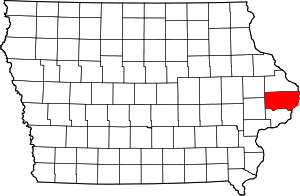






Please add profiles for those who were born, lived or died in Clinton County, Iowa.
Clinton County was formed on December 21, 1837. It was named for DeWitt Clinton, a Governor of New York and most ardent advocate for the construction of the Erie Canal.
In 1835, Elijah Buell built a log cabin for himself and his family and was thus the first settler of the region. In 1854, the first newspaper was issued and in 1858, the Lyons Female College for girls opened its doors.
The county has used three courthouses in its history. The structure currently in use was constructed in Romanesque style and opened in 1897.
Clinton county was first settled in 1836, by Mr. Bourne, who located upon Sec. 1, T. 80, R. 4, East. The county was surveyed in 1837, by the Messrs. Burtz. In 1840, the county was organized by Sheriff Bourne. In 1841, R. R. Bedford and others formed a little settlement at De Witt, and during the same year Messrs. Wheeler and Evans erected a log court-house. In stepping from the past to the present, we quote the language of one of the "oldest inhabitants." He says: "Clinton County was originally settled by the poorest class of people on God's earth; and it is with great pleasure that I have witnessed their progress, slow but sure, and now find the most of them very comfortably situated."
Other townships: Bloomfield, Brookfield, Center, Deep Creek, Eden, Elk River, Grant, Hampshire, Liberty, Olive, Orange, Sharon, Spring Rock, Washington and Waterford
Mississippi River National Wildlife & Fish Refuge (part)
National Register of Historic Places
